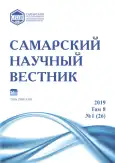Sanitary and chemical indicators of surface water source and drinking water on the Kola coast (on the example of Severomorsk)
- Authors: Konovalova I.I.1, Trotsenko A.A.2, Khazov P.A.1
-
Affiliations:
- Petrozavodsk State University
- Murmansk Arctic State University
- Issue: Vol 8, No 1 (2019)
- Pages: 42-47
- Section: 03.02.00 – General Biology
- URL: https://journals.rcsi.science/2309-4370/article/view/21579
- DOI: https://doi.org/10.17816/snv201981106
- ID: 21579
Cite item
Full Text
Abstract
The paper presents data on the study results of sanitary and chemical indicators of water from the surface source and drinking water in Severomorsk for the period 2017–2018. The authors have revealed that the main indicators (smell, iron, pH, total hardness, chlorides, sulfates, ammonia nitrogen, nitrates and nitrites) of the water in the capital of the Northern fleet fully complies with SanPiN 2.1.5.980-00 «Hygienic requirements for the protection of surface water». During the study period, there were slight fluctuations in indicators due to seasonal dynamics. The analysis of the data showed that drinking water in all areas of Severomorsk in color in 2017 exceeds the limit of MPC. The greatest excess is observed in summer. This is due to the fact that in spring and summer a large number of fulvic and humic acids, which lead to an increase in color, comes to the pond with rain and swampwaters. A direct dependence of color on iron parameters was also revealed. The iron content in drinking water for 2017–2018 exceeds the MAC boundary, which can be associated with water stagnation, which causes an increase in the concentrations of this indicator. The obtained data can be used in the implementation of measures to improve water treatment, drinking water treatment and allocation of the necessary funds for the implementation of the plan of utilities overhaul.
Full Text
##article.viewOnOriginalSite##About the authors
Ineya Igorevna Konovalova
Petrozavodsk State University
Email: trotcenko2007@yandex.ru
student of Medicine Institute
Russian Federation, PetrozavodskAlla Anatolyevna Trotsenko
Murmansk Arctic State University
Email: trotcenko2007@yandex.ru
candidate of biological sciences, associate professor of Physical Culture, Sports and Life Safety Department
Russian Federation, MurmanskPavel Andreevich Khazov
Petrozavodsk State University
Author for correspondence.
Email: trotcenko2007@yandex.ru
student of Medicine Institute
Russian Federation, PetrozavodskReferences
- Бенчмаркинг качества питьевой воды / ред. Г.Г. Онищенко, Ю.А. Рахманин, Ф.В. Кармазинов, В.А. Грачев, Е.Д. Нефедова. СПб.: Новый журнал, 2010. 463 с.
- Руководство по обеспечению качества питьевой воды [Электронный ресурс] // Всемирная организация здравоохранения. 2004. Т. 1. - http://who.int/ water_sanitation_health.
- Зарубина Р.Ф., Копылова Ю.Г. Оценка качества природных вод различного назначения. Томск: Изд-во ТПУ, 2009. 115 с.
- Троценко А.А., Журавлева Н.Г., Будилова Е.В., Мигранова Л.А., Терехин А.Т. Влияние демографических и природно-климатических факторов на неспецифический иммунитет жителей Республики Карелия и Мурманской области // Народонаселение. 2010. № 1 (47). С. 113-119.
- Лямаев Б.Ф. О водопроводной, доочищенной и бутилированной воде // Вода и экология: проблемы и решения. 2003. № 1 (14). С. 18-26.
- ГОСТ 31942-2012. Вода. Отбор проб для микробиологического анализа. М.: Стандартинформ, 2013. 28 с.
- ГОСТ 33045-2014. Вода. Методы определения азотсодержащих веществ. М.: Стандартинформ, 2016. 23 с.
- ГОСТ Р 56237-2014 (ИСО 5667-5:2006). Вода питьевая. Отбор проб на станциях водоподготовки и в трубопроводных распределительных системах водоподготовки. М.: Стандартинформ, 2015. 46 с.
- ГОСТ Р 31861-2012. Вода. Общие требования к отбору проб. М.: Стандартинформ, 2013. 36 с.
- СанПиН 2.1.5.980-00. Гигиенические требования к охране поверхностных вод. М.: Федеральный центр госсанэпиднадзора Минздрава России, 2000.
- ГОСТ 31954-2012. Вода питьевая. Метод определения общей жесткости. М.: Стандартинформ, 2010. 16 с.
- ГН 2.1.5.1315-03 Предельно допустимые концентрации (ПДК) химических веществ в воде водных объектов хозяйственно-питьевого и культурно-бытового водопользования. М.: Министерство здравоохранения Российской Федерации, Российский регистр потенциально опасных химических и биологических веществ Минздрава России, 2003.
- Доклад о состоянии и об охране окружающей среды Мурманской области в 2016 году. Мурманск: Кн. изд-во, 2017. 183 с.
- СанПиН 2.1.4.1074-01. Питьевая вода. Гигиенические требования к качеству воды централизованных систем питьевого водоснабжения. Контроль качества. М.: Федеральный центр Госсанэпиднадзора Минздрава России, 2002. 103 с.
- ПНД Ф 14.1:2:4.50-96. Количественный химический анализ вод. Методика измерений массовой концентрации общего железа в питьевых, поверхностных и сточных водах фотометрическим методом с сульфосалициловой кислотой.
- Постановление об утверждении Генеральной схемы очистки территорий муниципального образования ЗАТО г. Североморск от 22.03.2016. № 254.
- Пупырев Е.И. Технические регламенты и качество питьевой воды в России // Водоснабжение и санитарная техника. 2007. № 2. С. 1-7.
Supplementary files









